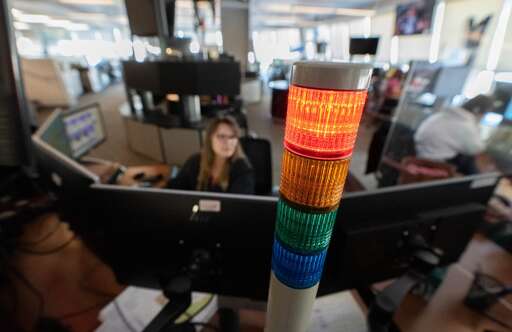Musk’s Starlink hit with hours-long outage after rollout of T-Mobile satellite service
-
*one guy who is ruining the planet and purposely pushing laws that eradicate queer and trans people
Them: "We need a strong central government to protect everyone!"
Me: "Don't do that! If bad people get control there's gonna be trouble!"
Them: "You just hate people!" votes for strong government
Them when that strong government is then taken over by bad people:

-
Your options are limited not by random angry dude on the Internet, but by deliberate and calculated lack of development conspired between legislators and telecoms. Starlink will hit the limits imposed by physics and geometry, and then will get worse and worse the more people sign up.
You seem to know a lot about these limits, can you elaborate?
I don't think there are actual physics limitations on network capacity right now
-
That’s a ridiculously low bar in 2025. What even is twisted pair DSL??
I live in a country praised for its IT industry, digital government and whatever
I got off ADSL in 2024. Fucking lol. I don't even live on a farm or anything. Lucky to receive fiber though, now they want to prioritize 5G home connections instead.
-
HugesNet has low throughput but it's pretty reliable. I had high hopes for Starlink but it seems to be a dud.
I'm sorry, but not even having a Musk backed product as my only alternative could get me to use HugesNet's antifunctional service. Literally dialup is better.
-
I'm sorry, but not even having a Musk backed product as my only alternative could get me to use HugesNet's antifunctional service. Literally dialup is better.
That's what I hear, but my experience is different
-
Is that accurate though? Assume a satellite is in a decaying orbit (thus too low to contribute to Kessler syndrome on its own) and another satellite is in a different orbit eccentricity-wise but they both collide. Are we certain that none of the pieces from the collision would acquire enough speed to become boloids that contribute to Kessler syndrome?
Time to go down the rabbit hole that is orbital mechanics for me again. Byeeee lol
Edit: looks like the lowest orbit for starlink's first shell is at 550km which is very much above VLEO and would definitely be a factor in Kessler Syndrome.
Most starlink satellites are set to deorbit themselves upon failure to avoid this. However the de orbiting could still fail and then it should take about a year or so to deorbit itself?
So it looks like there is a low possibility of it initiating Kessler syndrome. But it's not negligible.
For your question, no. There's no way for an object to have an orbit that doesn't intersect the same altitude where an impulse happened. They could be knocked into an eccentric orbit, but it at least has to have the lowest point at the highest point of the Starlink network.
This is not to say it can't hit something else after that changes the perigee at a later point in it's orbit, thus lifting it higher. For a single collusion though, no, at least with the collision alone.
-
You seem to know a lot about these limits, can you elaborate?
I don't think there are actual physics limitations on network capacity right now
The limited bandwidth of practical microwaves shared by everyone in the footprint of a satellite, which is thousands of square kilometres. More satellites help, but since it hears the signals from every person on earth in its footprint, even if that person is connecting to a different satellite, there are limited gains when you reach the point where they have a lot of overlap - literally limited by geometry. Compare that with fiber, which allows for virtually unlimited unshared service bandwidth that can get faster as it’s built out and becomes more popular.
-
The limited bandwidth of practical microwaves shared by everyone in the footprint of a satellite, which is thousands of square kilometres. More satellites help, but since it hears the signals from every person on earth in its footprint, even if that person is connecting to a different satellite, there are limited gains when you reach the point where they have a lot of overlap - literally limited by geometry. Compare that with fiber, which allows for virtually unlimited unshared service bandwidth that can get faster as it’s built out and becomes more popular.
Beam steering largely mitigates most of these problems. Fiber is definitely more scalable, but also far more expensive (somehow...) to provide last mile to the entire planet.
-
Beam steering largely mitigates most of these problems. Fiber is definitely more scalable, but also far more expensive (somehow...) to provide last mile to the entire planet.
From orbit, whole regions are within a few degrees arc from the perspective of orbit. It’s not enough to overcome what is fundamentally a business hype problem. Starlink is wonderful tech for remote outposts, boats, disaster areas, emergency service workers, and things like that, but those customers would never pay enough to be profitable, so they have marketed it as general purpose internet, so it will get slower the more people sign up.
-
From orbit, whole regions are within a few degrees arc from the perspective of orbit. It’s not enough to overcome what is fundamentally a business hype problem. Starlink is wonderful tech for remote outposts, boats, disaster areas, emergency service workers, and things like that, but those customers would never pay enough to be profitable, so they have marketed it as general purpose internet, so it will get slower the more people sign up.
Yes, with the current network this is true. I guess it feels like you're discounting the future growth of the constellation
-
Yes, with the current network this is true. I guess it feels like you're discounting the future growth of the constellation
More birds in orbit just hear more and more overlapping signals from the huge ground area they are over, and so share bandwidth. There’s a reason cell towers get lower and lower the more dense the population.







